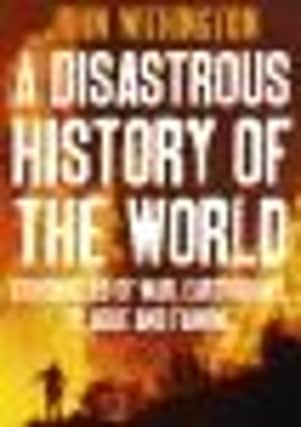Book review: A Disastrous History of the World by John Withington


It may sound like a terrifying science fiction scenario but it actually happened 74,000 years ago at what is now Lake Toba on the Indonesian island of Sumatra.
Yes, the current crop of tsunamis, earthquakes, floods, deadly flu viruses and terrorist activity might have made you think the world is getting more dangerous.
Advertisement
Hide AdAdvertisement
Hide AdYou were wrong. Withington’s compelling and sometimes gruesome journey through the nastiest things that have happened to humans reveals a catalogue of deadly disasters since the dawn of time.
Some populations took years to recover from their catastrophes while empires and dynasties have been known to topple under the pressures of rebuilding homes and lives.
Not so the Japanese...an earthquake which hit Tokyo in 1923 destroyed 300,000 buildings, killed around 150,000 people, made 1.9 million homeless and wiped out the political leadership when their cabinet room collapsed.
Within seven years, the city had been completely restored with scarcely a visible scar.
Advertisement
Hide AdAdvertisement
Hide AdMost of us can still recall clearly the horror of the deadliest ever tsunami (a Japanese word meaning ‘harbour wave’) on Boxing Day in 2004 when nearly 1,000 miles of fault-line slipped west of Sumatra causing an undersea earthquake registering 9.3 on the Richter scale.
It killed 230,000 people and was of a ferocity that happens only once every 500 years.
Nearer to home, the ‘Great Storm’ of November 1703 caused chaos around the southern counties of Britain.
‘No pen could describe it, nor tongue express it, nor thought conceive it,’ wrote Robinson Crusoe author Daniel Defoe of the country’s worst storm in recorded history.
Advertisement
Hide AdAdvertisement
Hide AdGales reaching over 140mph ripped the roof off virtually every house in Swansea, razed 1,000 buildings in Kent alone, felled thousands of trees, stripped the leading off Westminster Abbey and whisked men and animals into the air.
And who would have thought that a hailstorm could be so lethal? In northern India in 1888, hailstones almost the size of melons and weighing up to two pounds fell for only two minutes but still managed to kill 246 people.
At the other end of the temperature scale, a heatwave during America’s Great Depression in the 1930s killed 15,000 people. In Steele, North Dakota, the thermometer reached a sweltering 49 degrees and the ‘wide Missouri’ at Kansas City was reduced to ‘a languid thread of water’.
One of the strangest disasters occurred at Lake Nyos in western Cameroon in 1986 when 1,700 people dropped dead after a volcanic eruption under the lake emitted a huge bubble of colourless, odourless, poisonous carbon dioxide.
Advertisement
Hide AdAdvertisement
Hide AdAnd the already declining Roman Empire was devastated by the Plague of Cyprian which took hold in 251AD and raged for 20 years, claiming 5,000 lives a day at its height. The symptoms were horrific – sickness, burning fever, eyes ‘on fire’, blindness, deafness and gangrene.
Scientists today are still unclear of the exact cause but some suggest it could have been smallpox, typhus or even a virulent measles.
Of course, not all disasters are due to the forces of nature. Man-made catastrophes like wars, invasions, riots, fires, stampedes, shipwrecks and air and rail crashes have also taken a terrible toll.
In a bizarre incident in 1856, lightning struck a church on the Greek island of Rhodes, blew up a cache of gunpowder in the vaults and killed 800 people.
Advertisement
Hide AdAdvertisement
Hide AdAnd in wartime France in December 1917, 800 French soldiers looking forward to Christmas away from the hell of the trenches on the Italian front were killed when their 19-coach train crashed after careering down an Alpine slope.
Because of censorship, the facts remained hidden until 15 years later when the driver, who survived, told his story.
Withington’s well-researched book presents disaster on an epic scale and it makes a horribly fascinating and gripping story.
Brace yourself.
(Piatkus, paperback, £9.99)